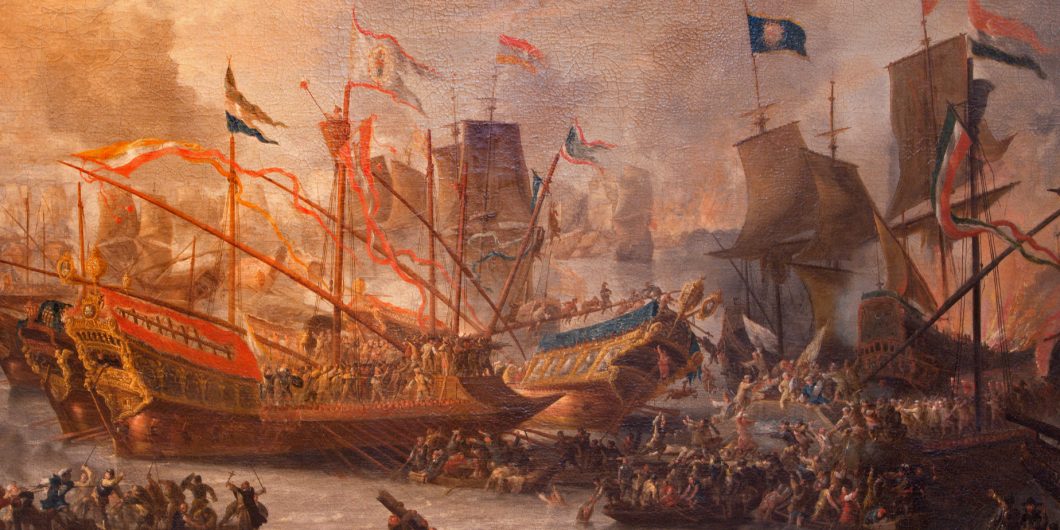Renewing Beauty and Terror
Tapestries were the artistic glory of the Renaissance era, requiring creativity, skill, patience, and often international collaboration. These same qualities distinguish Catherine Fletcher’s The Beauty and the Terror, a tightly woven panorama of the political, religious, socio-economic, cultural, and artistic developments of that exciting age.
Renaissance tapestries took two different forms: the traditional Flemish format, with designs and patterns scattered across a decorative field, and the newer Italian format, which burst with narrative scenes coming to life amid the silken threads. If Dr. Fletcher’s book were a tapestry, it would belong to the Flemish category, with myriad personalities, monuments, and events forming engaging patterns, including several chapters that shine like golden threads. These patterns of politics, war, faith, technology, and art mesmerize the reader as each new detail comes to life over her twenty-six chapters, sweeping the reader from the Fall of Constantinople to the Battle of Lepanto.
Fletcher has undertaken a herculean task, mustering an extraordinary amount of research, ranging from contemporary chronicles and diaries to the most recent scholarship, to recount the densely interconnecting political, economic, and cultural circumstances of 15th and 16th-century Europe.
The narrative is enlivened by the dizzying proliferation of dramatis personae from the Renaissance era: the kings of Spain, France, and England have key roles, as do the despots of countless duchies and marks, alongside the movers and shakers of the Italian republics (and this is just the political sphere). To that impressive array, Fletcher adds painters, writers, scientists, preachers, explorers, and inventors strutting and fretting their moments on the page. Each character sketch is both pithy and memorable, but it requires more than a little familiarity with the period to keep things straight. A few diagrams for the most important dynasties, a list of papal successions, and some maps to orient the reader amid the erratic patchwork of Italian sovereign states, would be helpful to the general reader.
The papacy, with its multifaceted politics, patronage, and family, occupies much of the book. Fletcher’s clear, objective prose shines here; her tone as she discusses the problematic papacy of Alexander VI Borgia is far more nuanced than that of most other authors. She extends that subtlety to her outlines of religious figures, distancing both Savonarola and Martin Luther from their typical caricature-like portrayals and at one point creatively contrasting them with one another. Her approach is also distinguished by a willingness to entertain the notion that the piety of the age was sincere, at least at times, and that God played a vital role in this society, an idea often dismissed by scholars who a-critically proclaim the Renaissance as the absolute triumph of secularism. Her observations of the past often invite comparisons with the present. As she describes the downfall of Savonarola, for instance, she notes that “while the Florentines may have endorsed the rhetoric of moral renewal… heavy-handed policing of daily lives aroused resentment.” Readers might note a parallel in the reactions to restrictions during the 2020 pandemic.
Fletcher’s fast-paced tour through history occasionally pauses to introduce the reader to some of the lesser-known artistic wonders of the age. She dedicates pages to the exquisite work of Pinturicchio in the Borgia Apartments in the Vatican Museums and her perspective does much to rehabilitate this much maligned artist. Interestingly, the most renowned achievements in the visual arts — the Sistine Chapel, Leonardo’s Last Supper and Raphael’s School of Athens—are given cursory treatment in contrast to the lavish description of Giuliano Romano’s Palazzo Te in Mantua. Fletcher thus invites viewers to look at Italian Renaissance art differently, not as a list of tourism’s top ten, but as varietals from different terroirs, each one with its own premier cru —an approach much appreciated by this art historian.
Of the many fascinating chapters, few are as enthralling as Chapter 16“War of Words”, which details the development, diffusion, and impact of the printing press. The chapter brims with data that highlights the remarkable opportunities that this new medium offered women. Fletcher introduces the reader to a parade of extraordinary female writers, flanked by testimonies of the numerous men who admired and encouraged them.
Women are brought frequently to the fore throughout the book. Readers encounter the forceful personalities of Caterina Riario Sforza and Isabella D’Este, as well as the more meditative figures of Vittoria Colonna or Laura Battiferri degli Ammannati. Fletcher’s analysis of the circumstances of women during this age is clear, straight-forward, and well documented, without the usual handwringing over a perceived “oppressive” and “patriarchal” society.
As the title of the work suggests, the age that produced so much beauty was also marked by terror. Fletcher’s precise, lusty descriptions of death, battle, and the ever-evolving methods of killing in the chapter “Weapons of War” would have earned her (in the day) the label of “virago,” a woman with combative characteristics usually associated with men. Her close scrutiny of the development of artillery, battle formations, and the etiquette vs. legislation of firearms drives home the often-forgotten fact that brutal and deadly conflicts were a continuous backdrop to the achievements of the Renaissance. Fletcher keeps the constant fear of the Ottoman threat on the horizon, inviting the reader to look at the Adriatic through Renaissance eyes to see a sun-speckled sea that might bring boats laden with riches, or vessels carrying a deadly disease, or warships bristling with hostile invaders.
The compression required for such a mammoth undertaking creates occasional problems in the text, especially when dealing with matters of religion. Readers will learn less about the actual Council of Trent in the homonymous chapter than the politics of its delays and postponements, and the personalities in attendance. There are some errors regarding sacraments, as where Fletcher claims that all Protestants were basically in agreement on the sacrament of communion, when in fact Luther and Calvin disagreed on the subject and the Catholic Church dedicated much attention in Trent to reinforcing the real presence of Christ in the Eucharist. This may seem a minor point, but this issue would shape most of the art, architecture, and liturgical practice of the following century in Italy and other Catholic nations.
The Beauty and the Terror marks the 150th anniversary of Burkhardt’s The Civilization of the Renaissance in Italy by renewing appreciation for this pivotal moment in history, at a time when many educational institutions are downgrading the humanities and succumbing to political correctness.
Similarly, the final chapter, “The Battle of Lepanto,” is regrettably terse, given the importance of the event. Fletcher downplays the menace of Ottoman fleet, noting that for each Turkish atrocity, Christians have one to match, and the battle comes across as more of a publicity ploy for the Catholics than a real fear of a possible Islamic occupation of Italy. She makes much of the torture and death of Marc Antonio Bragadin at the hands of Ottoman commander Ali Pasha but fails to note that two of the victim’s brothers commanded warships in the battle. Nor does she mention —surprisingly, given her attentiveness to women— Maria “Bailiarola,” a dancer/warrior friend of Cervantes, whom history claims was the first to board the enemy flagship. The Roman Colonna family, although prominently featured throughout the book, is barely accounted for in the context of the battle. And the commander of the fleet, Don Juan of Austria, is granted only a passing mention. In this battle where merchant ships flanked war vessels, and economics, warcraft, technology, and religion were so closely intertwined, this seems a missed opportunity to draw the many strands of her tapestry into a neat knot.
Instead, Fletcher brings the narrative to a close with an epilogue, “Hard Power to Soft,” which showcases the lasting effects of the Renaissance throughout history, even to the present day. It makes for a smooth landing after the raucous ride through that turbulent era and closes the book on a note of hope.
In 1860, Jacob Burkhardt ignited the imagination of Europe with his masterpiece The Civilization of the Renaissance in Italy. The interdisciplinary approach of the Swiss theologian-turned-historian launched art history, galvanized tourism, and settled Italy firmly as the birthplace of modern Europe. Whether or not it was intended, The Beauty and the Terror marks the 150th anniversary of Burkhardt’s endeavor by renewing appreciation for this pivotal moment in history, at a time when many educational institutions are downgrading the humanities and succumbing to political correctness.
Fletcher gives in only once to the lure of “wokeness,” in the case of race and slavery. In the chapter “Art of War,” she paints Francesco del Giocondo as a “ruthless” slave trader, although the women he brought were baptized, a sacrament that generally brought manumission. She also asserts (without evidence) that the African page in Titian’s portrait of Laura Dianti is a slave, in line with a modern tendency to regard every person of color in European art as a sign of “systemic racism.” But Fletcher also cuts against these modern tendencies, especially as she reveals that Catholic beliefs formed the root of the implacable opposition to slavery, a moral view of humanity that eventually brought about abolition
The Beauty and the Terror comes at an opportune time in human history, inviting readers to recognize how 16th century culture still impacts our world today. The wondrous fruits of Renaissance art, literature, science, and technology grew in a ferment of violence, greed, oppression, and fear. One closes this book hoping that amid our present strife and terrors, contemporary society might produce a worthy legacy of its own.



